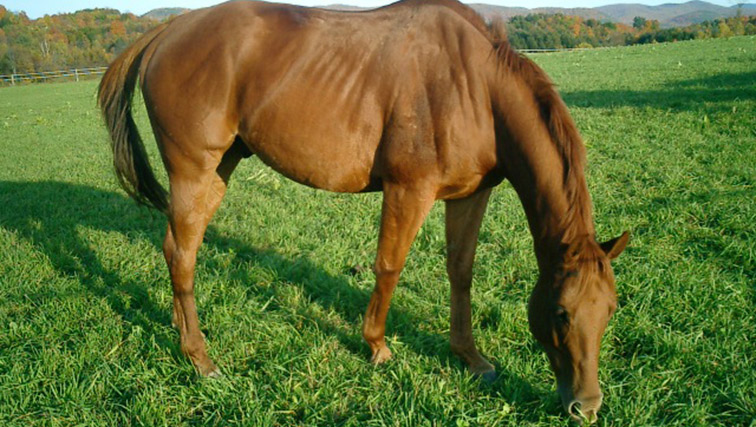Program Spotlight: AFTER The Track

One of AFTER The Track's Thoroughbreds grazes at the program's farm (Photos by AFTER The Track)
AFTER The Track started when longtime horseman Ginny Iverson learned of the need for suitable aftercare programs and the program acquired its first retired Thoroughbred in 2007.
“I have been training, breeding, boarding and competing horses for over 40 years. My niche was starting young horses, retraining problem horses, and bringing them along in dressage, eventing and pleasure,” Iverson said. “As an event rider I had several Thoroughbreds, and along the way, I became aware of the intense need for Thoroughbred racehorses to find new careers when their racing days are over.
“I began to research the need and what I learned was staggering. … I embarked on a mission to do my share to help these incredible animals. I acquired my first racehorse in 2007. I purchased another the following year and began to put my holistic retraining program into place.”
Since then the program, located in Hinesburg, Vt., has found new homes for three off-the-track Thoroughbreds with four horses currently in training.
Each horse new to the program is put into a Holistic Retraining Program, with the curriculum tailored to them based on an assessment of physical and mental needs.
Some horses leave AFTER The Track in as little as six months. Others can take more than a year to be suitable for adoption. However, when those horses are ready to be adopted they can be moved to a new owner fairly quickly.
The horses are marketed through a group of professionals that AFTER The Track is in contact with in different disciplines to assure the horses get the best home possible.
The five-step adoption process can be viewed on AFTER The Track’s website in addition to the adoption agreement, which requires that new owners update AFTER The Track on the horse’s progress three times the first year and once annually thereafter. In addition to allowing AFTER The Track see how its graduates are acclimating to their new homes, it also allows the program to see how its practices have worked on the horses after they leave the program.
AFTER The Track doesn’t worry about placing horses quickly, which gives potential adopters more time to get to know the animal.
“Our mission is to find a good match for each horse and to ensure a successful placement,” Iverson said. “We invite people to spend time with the horse, take lessons on the horse, bring their trainers to meet or ride the horse, complete a veterinary examination, etc., prior to adopting the horse. “
AFTER The Track has seen the popularity of off-the-track horses grow in recent years but recognizes that the Thoroughbred breed still isn’t as popular as it could be. Iverson cites a study recently completed by the Retired Racehorse Training Project as useful information on the work that still needs to be done in promoting the breed.
However, Iverson thinks that Thoroughbreds help sell themselves through their behavior and suitability for many different events.
“Thoroughbreds are highly intelligent and athletic horses,” she said. “They tend to be very sensitive and learn quickly. Thoroughbreds are demonstrating suitability for many disciplines of riding, especially eventing, dressage and showing, but are also excelling as western and pleasure horses.”
While Thoroughbreds are just like any other breed, potential retired racehorse owners must make sure that they are aware of what they are getting into when looking to give the horse a new home.
If an owner doesn’t have the experience needed to retrain their new Thoroughbred, they should bring in a trainer with Thoroughbred experience. As horses headed to the track are trained differently than recreational horses, the owner also needs to evaluate where their horse is at training-wise before starting the next phase of his or her training.
“Thoroughbreds are highly intelligent, very sensitive,” Iverson said. “I believe that can make them easy to teach, yet also easy to frighten and confuse. Horses off the track have already developed a solid work ethic, and it’s our duty to nourish that attitude while carefully guiding them into a new way of living, working and communicating. Read some of the excellent resources out there on retraining racehorses.”
AFTER The Track horses have found success, with the program’s graduates competing in a variety of disciplines. Two of the three AFTER The Track graduates have gone on to successful careers, with their third horse, Jimmy’s too Blue, expected to make his show debut this year.
In addition to helping retired racehorses, AFTER The Track also offers educational programs for high school in college students in multiple areas. Students can learn about business practices, farm management, and horsemanship through internships at the farm.
“We are currently hosting several high school interns and a group of interns from the University of Vermont. We welcome the opportunity to provide support to educational institutions and are happy to create situations to meet their needs,” Iverson said.
AFTER The Track is a 501 (c)(3) organization and relies on outside support for many different things. It is always looking for monetary and item donations in addition to welcoming help around the farm.
“We have a volunteer program and welcome people to our farm to help in any way possible, from weed whacking to painting,” Iverson said. “Our website includes information on how to donate or volunteer. Fans can also pass the word about the value of OTTBs and the work we are doing at AFTER the Track. We appreciate referrals, inquiries, visits, suggestions and notes. And please, like our Facebook page!”
For more information about AFTER The Track, you can visit the program’s site at www.afterthetrack.org.
If you know of a Thoroughbred Aftercare program that you think should be covered in America’s Best Racing’s Aftercare Program Spotlight, email Melissa Bauer-Herzog (mbauer-herzog@jockeyclub.com) with the program’s name and website.
